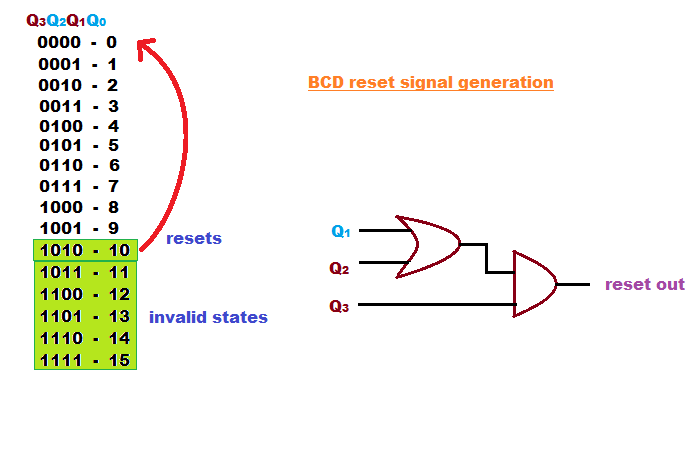4-bit BCD counter
- Transfer
- Tutorial

BCD means binary coded decimal - binary-decimal, that is, the counter counts from zero not to fifteen, but only to nine, and at the tenth pulse it is again reset to zero. To do this, it provides an additional node.
The counter itself, as usual, is a chain of four T-flip-flops:

An additional reset node is connected to the three high-order bits of the counter and is triggered at the moment of transition from the number 9 to the number 10, generating a reset signal, and instead of 10 it turns out immediately 0:

From the structural diagram we pass to the principal:

On a fragment of the circuit that is not highlighted in any color, four identical T-flip-flops are shown above. Buffer cascades are located a little lower, each of which matches the output of the previous trigger with the input of the next. The output of the fourth trigger through the same cascade is connected to the input of the first. The keys for controlling the LEDs are shown below. If an internal display is not needed, they can be excluded. Direct outputs Q0 - Q3 and inverse Q0 '- Q3' will continue to work as before.
An orange reset node is highlighted in orange. The switch in the lower position connects one of the three inputs of this node with a common wire, which makes the counter, if necessary, converted into a normal binary. Forced reset does not occur, the counter goes from the number 15 to the number 0 during overflow. In the upper position of the switch, all the required signals are received at the node input, a reset signal is generated as described above, and the counter works as a binary-decimal. The unit is arranged as follows: the OR element is made on two diodes, the element is on two transistors connected in series. Then there is a buffer cascade, from which through four diodes a reset signal is supplied to each of the four triggers.
Finally, a fragment with a clock is highlighted in green. It consists of a symmetric multivibrator and a buffer inverting cascade. The generator is needed only for debugging the circuit, then it must be excluded, and the counter input should be connected to the source of pulses that need to be counted.
Video device operation:
